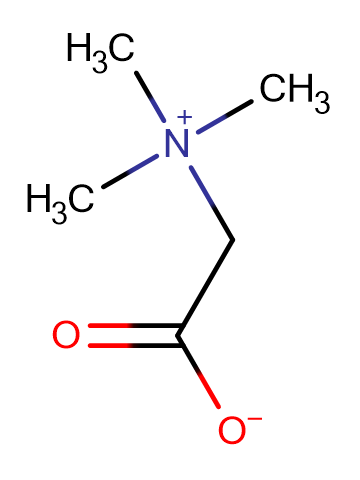
Betaine
CAS No. 107-43-7
Betaine( Glycine Betaine | N,N,N-Trimethylglycine )
Catalog No. M10307 CAS No. 107-43-7
Betaine is also known as trimethylamine, and is the quaternary ammonium derivatives of glycine and a class of N-methyl-compound or trimethyl inner salt after the hydrogen of the amino group being substituted by the methyl group.
Purity : >98% (HPLC)
 COA
COA
 Datasheet
Datasheet
 HNMR
HNMR
 HPLC
HPLC
 MSDS
MSDS
 Handing Instructions
Handing Instructions
| Size | Price / USD | Stock | Quantity |
| 1G | 38 | In Stock |


|
Biological Information
-
Product NameBetaine
-
NoteResearch use only, not for human use.
-
Brief DescriptionBetaine is also known as trimethylamine, and is the quaternary ammonium derivatives of glycine and a class of N-methyl-compound or trimethyl inner salt after the hydrogen of the amino group being substituted by the methyl group.
-
DescriptionBetaine is also known as trimethylamine, and is the quaternary ammonium derivatives of glycine and a class of N-methyl-compound or trimethyl inner salt after the hydrogen of the amino group being substituted by the methyl group.(In Vitro):Betaine (Trimethylglycine) inhibites proliferation of HeLa cells significantly.(In Vivo):Betaine (Trimethylglycine) attenuates liver-to-body weight ratio.
-
In VitroBetaine (Trimethylglycine) inhibites proliferation of HeLa cells significantly.
-
In VivoBetaine (Trimethylglycine) attenuates liver-to-body weight ratio.
-
SynonymsGlycine Betaine | N,N,N-Trimethylglycine
-
PathwayOthers
-
TargetOther Targets
-
RecptorOthers
-
Research AreaMetabolic Disease
-
Indication——
Chemical Information
-
CAS Number107-43-7
-
Formula Weight117.15
-
Molecular FormulaC5H11NO2
-
Purity>98% (HPLC)
-
SolubilityMethanol: 0.1?g/mL; Water 160 g/100 mL
-
SMILESC[N+](C)(C)CC([O-])=O
-
Chemical NameMethanaminium, 1-carboxy-N,N,N-trimethyl-, hydroxide, inner salt
Shipping & Storage Information
-
Storage(-20℃)
-
ShippingWith Ice Pack
-
Stability≥ 2 years
Reference
1.Kim DH, et al. Effect of betaine on hepatic insulin resistance through FOXO1-induced NLRP3 inflammasome. J Nutr Biochem. 2017 Apr 22;45:104-114.
molnova catalog



related products
-
Labetalone hydrochlo...
Labetalone hydrochloride is an impurity of Labetalol. Labetalol is an orally active adrenoceptor blocking drug, Labetalol is a competitive antagonist at both alpha- and beta-adrenoceptor sites.
-
cis-BBD
cis-BBD can be used antifungal studies.
-
ms48107
MS48107 is a potent and selective positive allosteric modulator of G protein-coupled receptor 68 (GPR68). It is selective for GPR68 over the closely related proton GPCRs, neurotransmitter transporters, and hERG ion channels. It can readily cross the blood-brain barrier (BBB) in mice.



 Cart
Cart
 sales@molnova.com
sales@molnova.com


